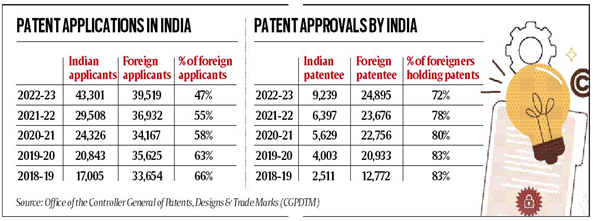Why in News?
For the first time, domestic patent applications in FY24 have surpassed those from foreign applicants, largely due to a surge in applications in fields like computer science, IT, pharmaceuticals, and chemicals.
Still, foreign entities hold a significant portion of the patents awarded in India - nearly two-thirds of all applications that are approved.
What’s in Today’s Article?
- What is a Patent?
- Domestic Patent Applications in India
- Foreign Patents in India
- India’s R&D Spending and its Impact
- Government Initiatives to Boost Intellectual Property (IP) Ecosystem in India
What is a Patent?
- A patent is an exclusive right provided by the government to the applicant for his/her disclosed invention of an industrial product or process that must be
- Novel,
- Non-obvious,
- Useful, and
- Patentable as defined by national law.
- A patent provides a technological solution to a technical challenge.
- The government grants legal protection to inventions for a limited time, i.e., 20 years from the date of filing.
- What is and is not patentable in India is explicitly stated in the Indian Patents Act 1970.
- The Controller General of Patents, Designs & Trademarks (CGPDTM) is considered as the principal officer responsible for administering the patent system in India.
Domestic Patent Applications in India:

- Steadily increasing since FY19: Residents' share of all requests submitted to the patent office increased from 34% in FY19 to 53% in FY24, when it came to patent applications.
- Issues with domestic patent applications:
- These have not yet translated into approvals because of the quality of patent applications as well as the patent ecosystem in the country.
- The quality of patent approval suffers from a lower number of patent examiners in the country (597 who approved over 1 lakh patents last year, whereas Germany has 821 and the US over 8,000 examiners).
- Also, the trend is reflective of the fact that patents often come with a built-in time lag due to various procedural timeliness.
Foreign Patents in India:
- Foreign patents approvals in India highest in any major economy globally:
- According to the CGPDTM data, patent approvals (an indicator of R&D activity) continue to be skewed in favour of foreign entities, with global IT giants (Qualcomm Inc., Samsung, Huawei and Apple) taking the lead.
- Patents approved for non-resident Indians and entities stood at 76.46% in 2022, which is among the highest in any major economy globally.
- The World Intellectual Property Organization (WIPO) data showed that the comparable number in the case of China stood at 12.87%.
- Reasons for high foreign patent in India:
- The wide gap between domestic and foreign patent holders reflects the inefficiencies in India’s R&D capabilities.
- Lower R&D activity results from weak private investments and stagnant government spending.
- This has also been fueled by Patent Cooperation Treaty (PCT) and Paris Convention for the Protection of Industrial Property, which is a source of 90% of the patents filed by foreign entities.
- India and PCT:
- In 1998, India ratified the PCT despite having any compulsion to do so.
- Around 142 countries are members of PCT and it provides great ease for a multinational company (MNC) to file patents in multiple countries simultaneously.
India’s R&D Spending and its Impact:
- Stagnation in India’s spending on R&D as a percentage of GDP: As per World Bank data, it has slipped to 0.65% in 2022 (from 0.83% seen in 2008) and this is much lower than the global average of 2.62%.
- Impact:
- This has resulted in Indian manufacturing depending on imported machinery, parts, and foreign technicians to fulfil export orders.
- Notably, India has a trade deficit with 8 out of the top 10 trade partners. India’s imports in FY24 from China alone crossed $100 billion.
Government Initiatives to Boost Intellectual Property (IP) Ecosystem in India:
- Scheme for Startups Intellectual Property Protection (SIPP):
- The scheme is designed to promote and mentor new and emerging technologies among Startups.
- It aids them in protecting and commercialising them by offering access to high-quality IP services and resources.
- National Intellectual Property Rights (IPR) Policy: It was launched in 2016 by the Union Ministry of Commerce and Industry's DPIIT to promote a more innovative and imaginative Bharat.
- Draft Model Guidelines on Implementation of IPR Policy for Academic Institutions: Its mission is -
- To establish an efficient, fair, and transparent administrative process for ownership control, assignment of IP rights, and
- Share revenues generated by IP created and owned by the academic institution.
- National Intellectual Property Awareness Mission (NIPAM): It aims to educate 1 million students on intellectual property and its rights.









